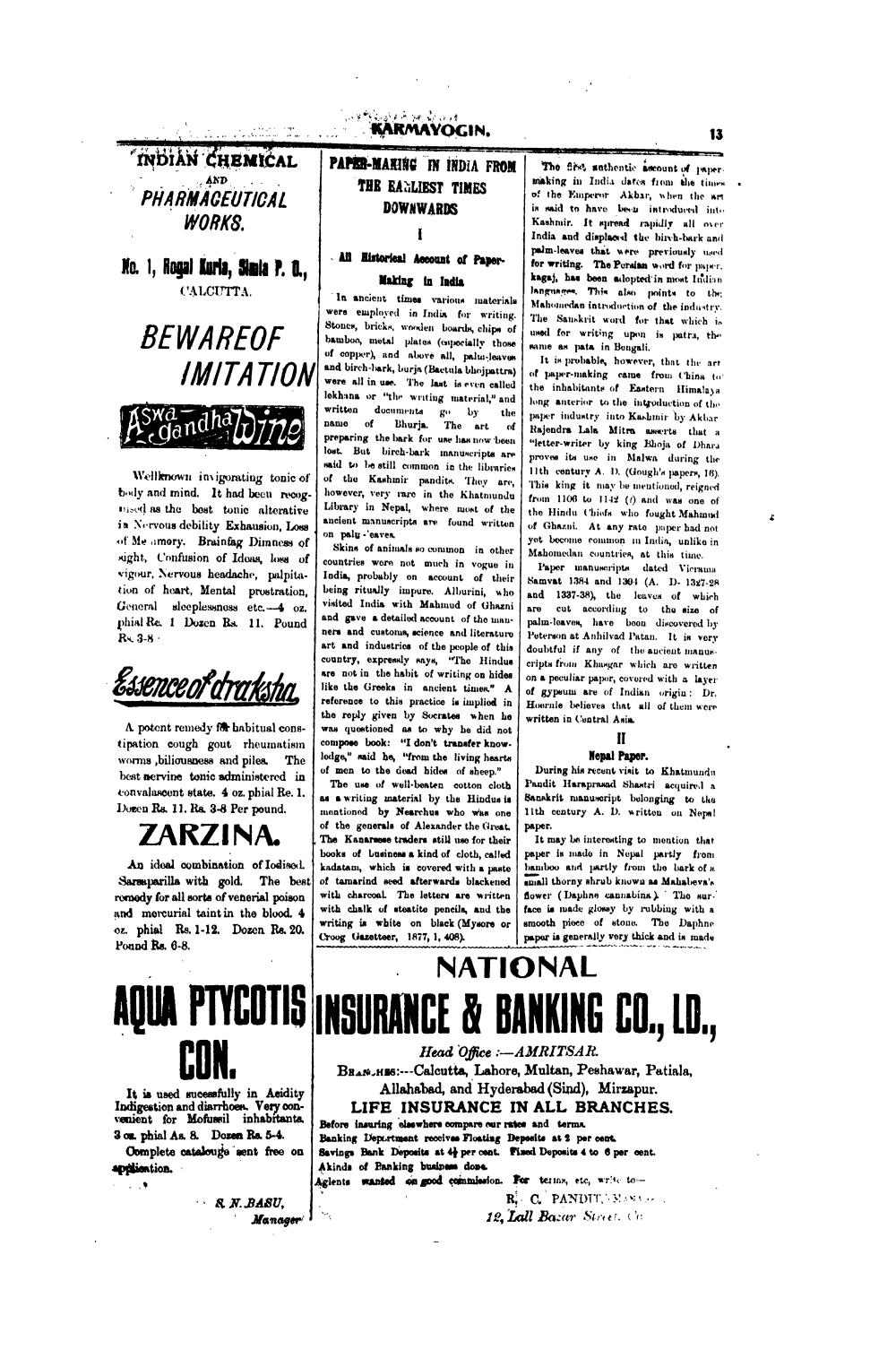________________
INDIAN CHEMICAL
AND
PHARMACEUTICAL WORKS.
No. 1, Rogal Kuria, Simla P. D.,
CALCUTTA.
BEWAREOF IMITATION
Aswadha
Wine
Wellknown invigorating tonic of bly and mind. It had been recognised as the best tonic alterative in Nervous debility Exhausion, Loss of Memory. Brainfag Dimness of sight, Confusion of Idous, loss of vigour, Nervous headache, palpitation of heart, Mental prostration, General sleeplessnoss etc.-4 oz. phial Re. 1 Dozen Bs 11. Pound R 3-8
Essence of draksha
A potent remedy for habitual constipation cough gout rheumatism worms,biliousness and piles. The best nervine tonic administered in convalascent state. 4 oz. phial Re. 1. Dozen Rs. 11. Ra. 3-8 Per pound.
ZARZINA.
An ideal combination of Iodised. Saraparilla with gold. The best romedy for all sorts of venerial poison and mercurial taint in the blood. 4 oz. phial Rs. 1-12. Dozen Re. 20. Pound Rs. 6-8.
CON.
It is used sucessfully in Aeidity Indigestion and diarrhoen. Very convenient for Mofussil inhabitants. 3 on phial As. 8. Dozen Rs. 5-4. Complete catalouge sent free on application.
KARMAYOGIN.
PAPER-MAKING IN INDIA FROM THE EAGLIEST TIMES DOWNWARDS I
& N.BASU, Manager
All Historical Account of PaperMaking in India
In ancient times various materials were employed in India for writing. Stones, bricks, wooden boards, chips of bamboo, metal plates (especially those of copper), and above all, palu-leaven and birch-bark, burja (Bactula bhojpattra) were all in use. The last is even called Jokhang or the writing material," and written documents go by the The art Bhurja. preparing the bark for use has now been lost. But birch-bark inanuscripts are said to be still common in the libraries. of the Kashmir pandits. They are, however, very rare in the Khatmundu Library in Nepal, where most of the ancient manuscripts are found written
Danie of
of
The sathentie aseount of paper. making in India dates from the times of the Emperor Akbar, when the AM is said to have been introduced into Kashmir. It spread rapidly all over India and displaced the birch-bark and palm-leaves that were previously used writing. The Persian word for paper. kagaj, has been adopted in most Indian language. This also points to the Mahomedan introduction of the industry. The Sanskrit word for that which is used for writing upon is patra, the same as pata in Bengali.
for
It is probable, however, that the art of paper-making came from China to the inhabitants of Eastern Himalaya long anterior to the introduction of the paper industry into Kashmir by Akbar Rajendra Lala Mitra aserts that a "letter-writer by king Bhoja of Dhara proves its use in Malwa during the 11th century A. 1). (Gough's papers, 16). This king it may be mentioned, reigned from 1106 to 1142 () and was one of the Hindu Chiefs who fought Mahmud of Ghazni, At any rate paper had not yet become common in India, unlike in Mahomedan countries, at this time.
on palu-'eaves.
Skins of animals so common in other countries were not much in vogue in India, probably on account of their being ritually impure. Alburini, who visited India with Mahmud of Ghazni and gave a detailed account of the man ners and customus, science and literaturo art and industries of the people of this country, expressly says, "The Hinduscripts from Khangar which are written are not in the habit of writing on hides like the Greeks in ancient times." A reference to this practice is implied in the reply given by Socrates when he was questioned as to why he did not compose book: "I don't transfer know.
Paper manuscripts dated Vierama Samvat 1384 and 1301 (A. D. 1327-28 and 1337-38), the leaves of which are cut according to the size of palm-leaves, have boon discovered by Peterson at Anhilvad Patan. It is very doubtful if any of the ancient manus
on a peculiar paper, covered with a layer of gypsum are of Indian origin: Dr. Hoernle believes that all of them were written in Central Asia
II Nepal Paper.
ledge," said he, "from the living hearts of men to the dead hides of sheep."
During his recent visit to Khatmund Pandit Haraprasad Shastri acquire a Banskrit manuscript belonging to the 11th century A. D. written on Nepa! paper.
The use of well-benten cotton cloth as a writing material by the Hindus is mentioned by Nearchus who was one of the generals of Alexander the Great The Kanareese traders still use for their books of business a kind of cloth, called kadatam, which is covered with a paste of tamarind seed afterwards blackened with charcoal. The letters are written with chalk of steatite pencils, and the writing in white on black (Mysore or Croog Gazetteer, 1877, 1, 408).
It may be interesting to mention that paper is made in Nepal partly from bamboo and partly from the bark of small thorny shrub known as Mahaleva's flower (Daphne cannabina) The surface is made glossy by rubbing with a smooth piece of stone. The Daphne papar is generally very thick and is made
NATIONAL
AQUA PTYCOTIS INSURANCE & BANKING CO., LD.,
Head Office :-AMRITSAR
13
BRANCHES-Calcutta, Lahore, Multan, Peshawar, Patiala, Allahabad, and Hyderabad (Sind), Mirzapur. LIFE INSURANCE IN ALL BRANCHES. Before insuring elsewhere compare our rates and terma Banking Department receives Floating Deposite at 2 per cent. Savings Bank Deposits at 4 per cent. Fixed Deposits 4 to 6 per cent. Akinds of Banking business done. Aglents wanted on good commission.
For terins, etc, write to R. C. PANDIT, MA 12, Lall Bazar Street. On




